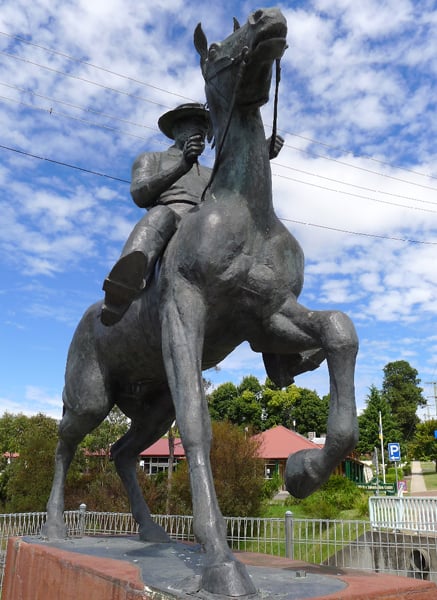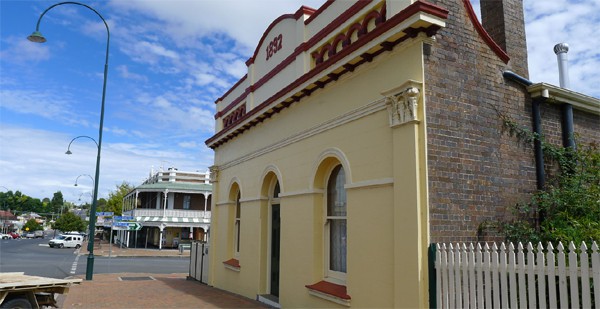Uralla is located 500km north of Sydney and 485km south of Brisbane where the New England Highway and Thunderbolt’s Way meet. The name Uralla was taken by European settlers from the dialect of the local Anaiwan people and means ‘meeting place’.
Uralla really is a classic Australian country town – one which many a traveller has stopped at to break up their journey as it is halfway between Sydney NSW and Brisbane. On my last drive through this part of Northern New South Wales I stopped here to enjoy a nice country lunch and there were several fabulous fresh bakeries and cafés choose from.
Uralla’s pride in its heritage and love of art and antiques is clearly apparent in this charming little town. There is a wide range of architectural styles found around its streets and a Heritage Walk has been developed to showcase many of these charming buildings and to tell their stories.
The history of Uralla goes back to1849, when the Government ordered a reserve be surveyed at the headwaters of the Rocky River which was to be suitable for a new village. Then in 1851, Samuel McCrossin erected an accommodation house, stables and Inn within this reserve. In 1855, streets were surveyed and the area named Uralla.
The new village of Uralla prospered in 1856, by the discovery of deep gold bearing leads within the nearby basaltic hills, as numerous allotments of land became available for purchase. Buildings began to appear, many of which were constructed with bricks handmade form the clay of creek banks and available basalt and granite. Many of these buildings still stand today.
The Uralla Heritage Walk is a self-guided walking tour which showcases over fifty heritage buildings and historical features within the township. The Heritage Walk takes one to two hours, depending on the level of interest. A printed Heritage Walk guide is available from the Visitor Information Centre, which includes a map of the walk and a short history of each building.
Walking down Bridge Street, which is the main street of Uralla, gives you a feel of what life was like when this little town was first established, with many of the buildings either restored or preserved to a high standard.
One striking old building dating back to 1881 is Stoker’s on Bridge Restaurant, the old Clays’ House which was built by the owner of Gostwyck Station as a retirement home for one of his most esteemed workers. The building features colonial bond brickwork upon a rubble basalt foundation. A standout feature is the glazed cedar door.
A few buildings down is the old Billiard Saloon and Bike Shop, now a Hair design Studio. Still looking like it did back in 1904 the quaint weatherboard structure with barrel vaulted upper parapet and clerestory windows, did have its awning and posts renewed in 2004.
Next door is the 1872 Salvation Army Citadel which was built for the sons and daughters of Temperance Lodge. There was an amazing palette of materials used in the construction – brick, coursed and uncoursed granite, basalt and random rubble walls. Now privately owned, it was used by the ‘Blood and Fire’ Salvation Army from June 1887 until the blood thinned and the fire dwindled in 2002.
Another in pristine condition is the 1892 Australian Joint Stock Bank. The original bank ceased operation during the 1890’s depression, then reopened as the Commercial Banking Company of Sydney in 1907 and then operated as the National Bank of Australia until 1995. Now a private residence, it is superbly refurbished with a splendid replica of the original picket fence.
There is another old bank further down Bridge Street. This building was built in 1874 and then purchased by the Bank of New South Wales for a banking office and manager’s residence in 1878. Originally it had a shingled roof and cast iron veranda posts and decorative cast iron panels.
Like any Australian country town, there is no shortage of pubs. At the top end of town is two of interest. One is the Imperial Hotel built in 1909 and renamed the Thunderbolt Inn in 1970, the centenary of the bushranger’s death. This late Victorian style building has an impressive façade and decorative iron posts, lace, brackets and frieze.
The other is the Great Northern Hotel built in 1881. It was built of Uralla brick with quoins of Uralla granite and decorative cast iron posts and lace. The second story was added in 1904. It is now known as the ‘Top End’ pub.
Another building that has undergone major restoration is the McCrossin Flour Mill. Built in 1870, the ground floor walls and the veranda footings are Uralla granite laid in neat rubble courses on huge granite block foundations. The first and second storeys are of red brick and lime mortar. In 1979 the Uralla Historical Society was formed to buy the then derelict building to restore it and turn it into a museum and function centre.
Replica street lights stand where the original gas ones once lit the way for the horse and cart. The lights with the white mahogany poles which were hand-worked in Uralla by a local in 1999 and handmade lanterns made by another local are the same as the street lights that stood from 1887 – 1906.
In other parts of town are replicas of the main street lighting from 1911 – 1918. The cast iron posts were cast from original patterns in a foundry in Uralla and the lanterns also locally handcrafted.
The town is famous for its connection with the bushranger Fred Ward, alias Captain Thunderbolt, who was killed near here in 1870. You can visit Thunderbolt’s Grave in the local cemetery.
Born in the early to mid-1830s, Ward was a hardworking bushranger. His extensive crime record states he robbed 25 mail coaches,16 stations and residences, six hawkers, one toll-bar gate and stole 80 horses. In 1856, he was sentenced to Cockatoo Island Prison, Sydney Harbour. His devoted wife Mary Ann Bugg, helped him to escape by swimming with him through the shark infested waters. Later, a police report about his death was left incomplete, stirring up great controversy that continues today. Was it Fred Ward, his brother, or perhaps someone else who was shot by Constable Walker at Kentucky Creek and laid to rest in the Old Uralla Cemetery? Nonetheless, a fine headstone for Fred Ward remains, as does the mystery of his death.
Thunderbolt’s statue can be found casting his steely gaze over Uralla’s main street. This life size statue was produced as a Bicentennial project and designed and cast by sculptor, Denis Adams. It was unveiled with much pomp and ceremony in 1988.
Few new buildings were built for 40 years and Uralla’s population remained at around one thousand, until the 1960s. Uralla’s cheaper land and low rates enticed new buyers and by the 1970s, newcomers recognised Uralla’s quaint heritage buildings. Now the whole community and visitors alike, value Uralla’s charm.
Story & Photography: John Heselwood
John is a proper adventurer who can't resist the call of the open road. He's got a real soft spot for discovering new and different places, and he's had the chance to visit a bunch of different countries. He's really experienced a wide range of cultures firsthand.
But his travels aren't just about going abroad. He's done a ton of exploring right in the United States, and he's loved every bit of it. He's all about learning new things about cultures and making new friends wherever he goes.
John is always on the lookout for the next adventure. No matter where he is, he's ready to dive in and explore. And the best part? He can't wait to pack his bags and continue his travels in the future.
With all the places he's visited and the experiences he's had, John has got some great stories to tell. So, if you're looking for travel advice or just want to hear about some cool cultural experiences, John's your man.



0 Comments